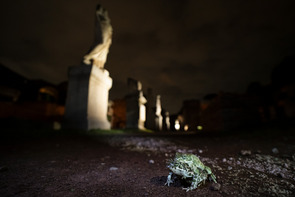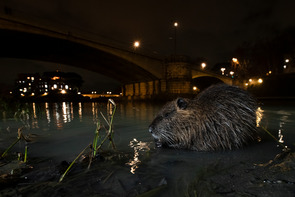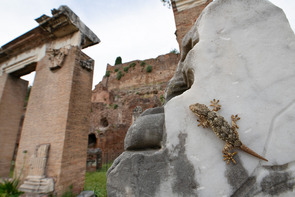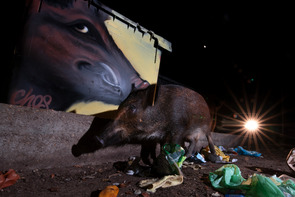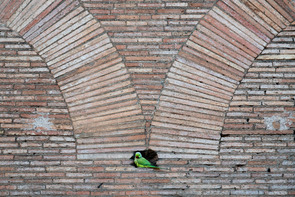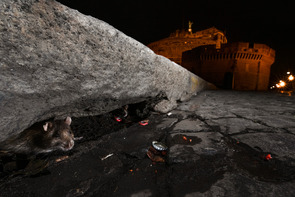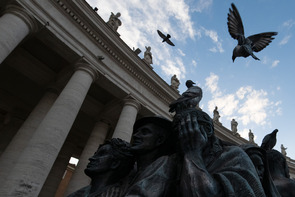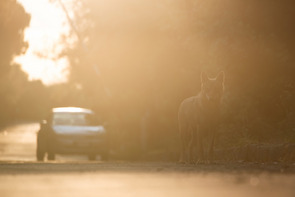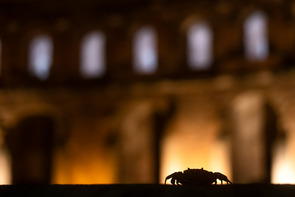Winner: Gianluca Damiani – Italy
Gianluca Damiani is a naturalist and wildlife photographer based in Rome. Passionate about nature and animals since childhood, Gianluca's interests currently centre on urban nature and conservation photography pertaining to Italy's endangered species. Having obtained a bachelor's degree in natural sciences and a master's degree in conservation biology, Gianluca is now working on his PhD exploring the effects of urbanisation on birds of prey. He is also the author of two books as well as several scientific and photography articles.
Gianluca's photography path initially took him to the wilds of Italy's mountains and remotest corners. Eventually, however, he returned to explore urban wildlife in this home town, Rome. With his photography, Gianluca aims to capture everyday scenes of coexistence between humans and animals in an unusual manner while simultaneously searching for the unexpected in the ordinary.
"I believe that nature photography is a powerful tool for getting people’s attention. With my images, I try to invoke awareness and awe. In this way, we can help save nature."
www.gianlucadamiani.com
www.instagram.com/gianlucadamiani_photographer/

Project: Urban jungle
Urbanisation is the fastest-growing anthropogenic land cover class and the conversion of natural habitats to urban areas is also increasing. The human population continues to grow and our ecological footprint is unmistakable all over the world. These developments pose many new challenges for the Earth's animal and plant species. In many regions, species are forced to either adapt or flee.In urban areas, wild animals must make a wide range of behavioural and physiological adjustments to be able to exploit this expanding habitat type. While many species are negatively affected by increasing urbanisation, others are capable of behavioural and genetic adaptations to large metropolises such as Rome. Since ancient times, this city has been inhabited by large numbers of humans, and its history - influenced by Roman culture and the Catholic Church - is known around the world. Despite the fact that the city's endless streets, squares and buildings are currently populated by more than four million people and two million cars, a hidden natural world persists within Rome’s borders.
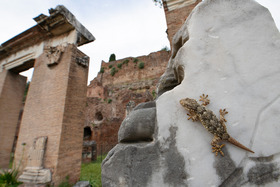 Urban predator
Urban predatorUrban areas can host complex habitats. In Rome, almost every corner of the city hides a wild secret. The ancient buildings of the Roman Forum are home to a large population of common wall geckos (Tarentola mauritanica). Thanks to a plethora of crevices and holes in these historic walls, the animals find ample refuges. Geckos are night-active and generally remain hidden during the day. Despite their nocturnal lifestyle, geckos occasionally come out to hunt on cloudy days. I found this magnificent specimen on an ancient Roman wall on Palatine Hill.
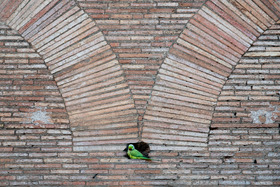 Alien in town
Alien in townA rose-ringed parakeet (Psittacula krameri) resting in a hole in an ancient wall of the Roman Forum in the middle of Rome. Colonies of this species have recently colonised numerous European cities. This invasive alien species benefits greatly from the significant global warming trend in the Mediterranean region and from the abundant ecological niches available in urban habitats. Parakeets are urban exploiters, well-adapted to urban life and able to benefit from available food resources and nesting sites. Their expansion threatens to displace other cavity-nesting birds and bats.
 Peregrine in Rome
Peregrine in RomeFrom high above the streets and buildings, a pair of watchful eyes has everything in view. The peregrine falcon (Falco peregrinus) is an apex predator. Brought to the brink of extinction in Italy in the 1980s by illegal hunting, widespread use of DDT, and air pollution, the peregrine falcon is now widespread in urban areas such as Rome. With more than 20 breeding pairs, Rome's peregrine falcon population is approaching its carrying capacity. Recently, new territories have been occupied, including the ancient walls of the Colosseum in the city centre. As part of my PhD project, I am studying and monitoring several falcon pairs and providing them with artificial nest boxes on high buildings.
This photograph was taken with the permission of the City of Rome and the Colosseum Archaeological Park; the peregrine falcon remained undisturbed on its perch well into the night. I thank Valerio Cortopassi and Luca Soriano for assistance with the drone.
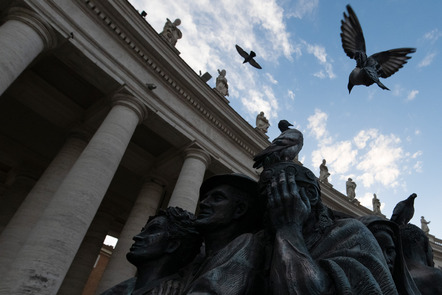
The rock pigeon (Columba livia) has probably always lived in cities, evolving together with humans and the urban environment. Saint Peter's Basilica in Rome, with its constant flow of tourists and worshippers, attracts countless pigeons and other urban birds searching for food.
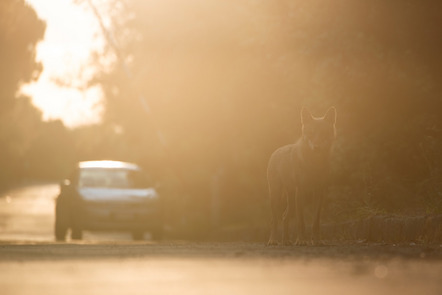
The Italian wolf (Canis lupus italicus) is a shy and wary animal. Because of its nocturnal lifestyle, encounters with humans are rare. This young male wolf is known to frequent the outskirts of a small village on the Mediterranean coast. After several days of searching, I spotted him one early morning on a narrow road at the edge of a forest. I lay down at the side of the road so that I could take advantage of the backlight as the wolf approached.
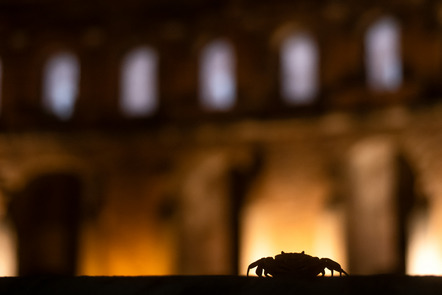
The city of Rome is home to many rare and endangered arthropods, of which the European freshwater crab (Potamon fluviatile) is certainly the most unexpected. Rome's urban crab population has been genetically and geographically isolated for centuries and exhibits insular gigantism. The freshwater crabs live in only one place within the city: in the sewers of the Roman Forum, between the canals and underground ponds just a few metres below the streets visited by millions of tourists. In the urban environment, these endangered crabs are particularly threatened by predation from cats, rats and seagulls. Following the discovery of the crabs under the Roman Forum in 2005, archaeological excavations and predation have resulted in the loss of more than 90% of the population. A large part of the crab's habitat has been irretrievably destroyed by the construction of footbridges for tourists and earthworks for underground railway lines.
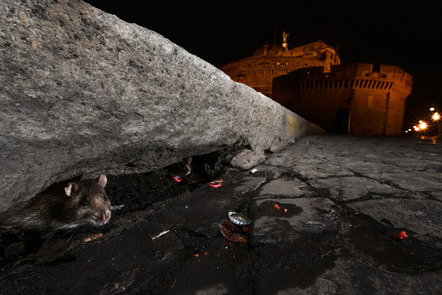
Large cities harbour many animal species, but the brown rat (Rattus norvegicus) is generally the most hated by humans. Urban rat populations are increasing because these rodents have amazing abilities to survive in large cities. They live in underground colonies and feed on human waste and diverse other resources. Every night in Rome, the famous Castel Sant'Angelo near the Vatican is flooded by countless rats in search of food. Despite their large numbers, the animals are very timid and flee immediately when approached. I set up my photo trap between the rubbish bags on the street to photograph the rats' nocturnal activities. I wanted to use this perspective to contrast the beloved monuments of Rome with its much despised rats. Showing the secret lives of these innocuous animals can help humans accept their presence in big cities.
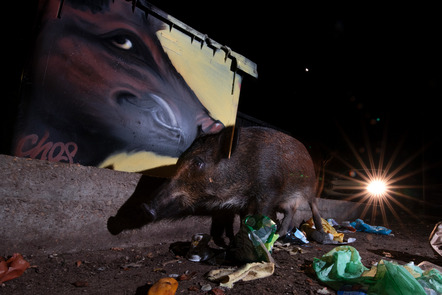
Urbanisation is increasingly encroaching on natural environments and severely decimating biodiversity. However, a small number of species manage to exploit the resources made available in urban centres. In recent years, the rubbish in Rome's city centre has enticed wild boars (Sus scrofa) to colonise and establish a local population. I had been following a family of wild boars for several months in the vicinity of my house and noticed that they often came to rummage through the rubbish at night. Their presence in heavy traffic and among unsuspecting passers-by can be a danger to both humans and the animals themselves. One night, a controversial graffiti appeared on one of the rubbish containers in the street: The face of a grinning wild boar. I immediately set up my photo trap and waited in the car a few metres away to capture the arrival of the boars - but nothing happened. I tried to get a good picture for several nights in a row, constantly surrounded by curious people, until finally the entire wild boar family came to feed directly in front of the graffiti dumpster.
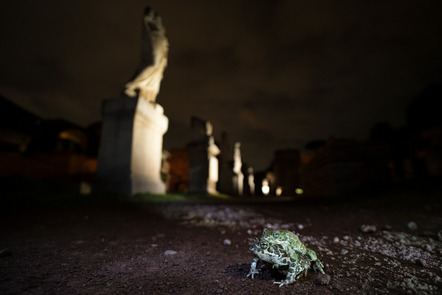
Although urban habitats may seem unsuitable for wildlife at first glance, they often offer small, safe niches for adaptable species. In the Roman Forum amidst the ancient buildings of the Roman Empire, a small population of the Balearic green toad (Bufotes balearicus) has persisted for centuries. On spring nights, dozens of toads meet to breed in the darkness near a small fountain located in the ruins of the House of the Vestal Virgins. Like other amphibians, this species is highly endangered due to pollution, habitat destruction and climate change. Trapped in Rome's urban jungle, the toad's survival is closely tied to the existence of this single small fountain.
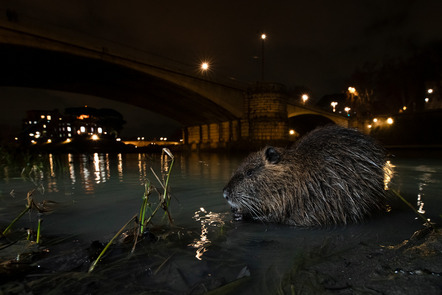
Native to South America, the nutria (Myocastor coypus) has spread to Italian rivers in recent years after several specimens were illegally released. Thanks to rising temperatures and low predation risk, nutria populations have established in several Italian cities. In Rome, the animals have followed the course of the Tiber and colonised the city centre. The timid and elusive nutrias are rarely seen by locals and tourists despite being widespread throughout the city. This rodent, yet another invasive alien species able to exploit urban habitats, is making headlines in Italy: Nutria digging activities along rivers and streams threaten to damage natural wetlands. I spent several summer nights immersed in dirty river water in order to document the hidden lives of nutrias under Rome's bridges. I used a remote shutter release to photograph the natural behaviour of the animal up close without causing disturbance.









